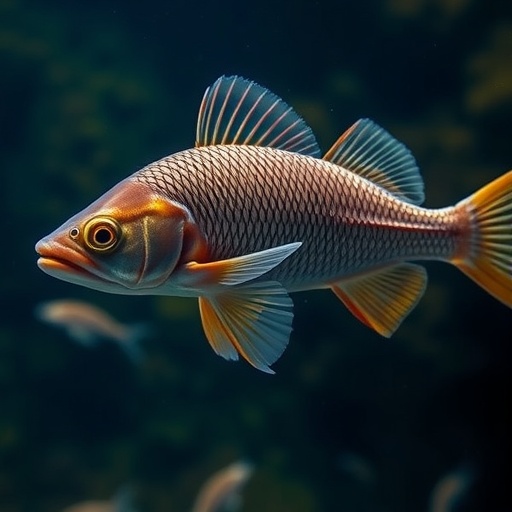In a remarkable development for biodiversity conservation, researchers have triumphantly announced the rediscovery of Moema claudiae, a seasonal killifish species endemic to Bolivia that had for decades been considered possibly extinct. This extraordinary finding not only rekindles hope for the species itself but also highlights the critical conservation status of the diverse and fragile wetland ecosystems within the region, which are under severe threat from anthropogenic pressures.
The rediscovery of Moema claudiae emerges after more than twenty years of absence from scientific observations. Historically, the species was known only from its type locality, a habitat that has since been irrevocably destroyed and converted into agricultural land. Despite comprehensive and targeted surveys aimed at locating surviving populations, the species had eluded detection and was designated as Critically Endangered, possibly extinct, under IUCN Red List criteria. Such a classification underscored the urgency and gravity of its precarious conservation status.
The breakthrough came during a recent series of field expeditions led by ichthyologists Heinz Arno Drawert and Thomas Otto Litz. Their perseverance was rewarded when they discovered a surviving population thriving in a small, ephemeral pond nestled within a remnant forest patch surrounded by agricultural fields. This finding was significant due to the location’s temporary nature and the precariousness of such isolated aquatic habitats amidst expanding human land use.
The rediscovery has been documented and detailed in an article published in the open-access journal Nature Conservation. For the first time in over two decades, scientists were able to capture live photographs of Moema claudiae, enabling detailed study of its behavior and previously unknown facets of its natural history. These insights are instrumental for formulating effective in situ conservation strategies tailored to the species’ ecology and life cycle.
A unique aspect of this habitat is its harboring of not only Moema claudiae but also six other species of seasonal killifish, constituting the most genetically rich assemblage of these fishes documented worldwide. This extraordinary biodiversity hotspot exists at the ecological crossroads where the Amazon rainforest meets the Llanos de Moxos savannas, a transition zone noted for its complex interactions between aquatic and terrestrial ecosystems. Such uniqueness accentuates the ecological value and conservation urgency of the area.
Killifishes, including Moema claudiae, exhibit fascinating life-history strategies adapted to seasonal wetlands, often with an annual lifecycle tightly synchronized with ephemeral water bodies. Their eggs undergo diapause, surviving dry seasons buried in substrate until subsequent rains re-establish aquatic habitats. This biological adaptation makes their conservation dependent on the integrity and connectivity of temporary aquatic systems, which are especially vulnerable to alterations caused by land conversion and climate variability.
The discovery comes at a critical time when Bolivia faces unprecedented deforestation and habitat loss. Over the past quarter-century, the nation has lost nearly 10 million hectares of forest, with alarming acceleration in recent years primarily driven by agricultural expansion. This land-use change not only reduces habitat availability but also fragments populations and disrupts ecosystem functions, jeopardizing species survival and ecological resilience at a landscape scale.
Co-author Thomas Otto Litz expressed his personal elation and scientific optimism upon the rediscovery, emphasizing the renewed opportunity to preserve Moema claudiae in its natural environment. The naming of the species, after Claudia, the wife of Prof. Wilson Costa, adds a poignant human dimension to this scientific narrative, reflecting decades of collaborative efforts and dedication in neotropical ichthyology.
The scientists underscore that urgent and decisive conservation action is imperative. Given that the newly discovered site represents the only known extant population of Moema claudiae, its protection is vital for preventing the total extinction of this unique taxon. Beyond species-level conservation, preserving this aquatic refuge also safeguards the globally significant assemblage of seasonal killifishes and their specialized habitats.
From an ecological perspective, the loss of such species and habitats entails more than biological impoverishment; it imperils the myriad ecosystem services these wetlands provide. These include water filtration, flood regulation, nutrient cycling, and the sustenance of local livelihoods. The degradation of these systems would undermine the region’s environmental stability and socio-economic well-being, emphasizing an intrinsic link between biodiversity conservation and human welfare.
Furthermore, Moema claudiae serves as an indicator species for the health of seasonal wetland ecosystems. Its persistence reflects the delicate balance of hydrological regimes and habitat conditions vital for the survival of numerous coexisting aquatic organisms. Protecting these ecological niches is critical to maintaining biodiversity patterns shaped over evolutionary timescales in this ecotone between tropical rainforest and savanna biomes.
The researchers call for integrative conservation strategies that combine habitat protection, sustainable land-use planning, and community engagement. Enhancing legal protections for remnant forests and aquatic habitats, alongside promoting awareness about the intrinsic and utilitarian values of biodiversity, are central to fostering resilient ecosystems capable of withstanding ongoing environmental changes.
In conclusion, the rediscovery of Moema claudiae represents more than a mere biological curiosity—it is a beacon of hope illuminating pathways for conserving some of the most imperiled and ecologically valuable habitats on Earth. This discovery reignites scientific and public interest, providing a critical impetus for safeguarding Bolivia’s wetlands and their myriad extraordinary inhabitants before they vanish irrevocably.
Subject of Research: Rediscovery and conservation of the seasonal killifish species Moema claudiae in Bolivia.
Article Title: Rediscovery of a thought to be extinct beauty: a second chance for conservation
News Publication Date: 14-Nov-2025
Web References:
https://natureconservation.pensoft.net/
DOI: 10.3897/natureconservation.60.160386
References:
Drawert HA, Litz TO (2025) Rediscovery of a thought to be extinct beauty: a second chance for conservation. Nature Conservation 60: 115-124.
Image Credits: Heinz Arno Drawert and Thomas Otto Litz.
Keywords: Moema claudiae, Bolivian killifish, seasonal wetlands, biodiversity hotspot, species rediscovery, conservation biology, habitat loss, deforestation, Amazon-Llanos ecotone, aquatic ecosystems, genetic diversity, ephemeral ponds
Tags: agricultural land conversion impactsanthropogenic threats to wildlifeBolivia biodiversity effortsconservation status of fish speciescritically endangered fish speciesendangered species recovery initiativesephemeral pond habitatsichthyology field expeditionsIUCN Red List updatesMoema claudiae rediscoveryseasonal killifish conservationwetland ecosystem preservation





